
Junior Boys Begone Dull Care
(Domino)
As the first decade of a new millennium draws to a close, and many a critic laments the impending death of the album, it’s nice to listen to a band that still looks at a record as a 10 inch vinyl circle of art that moves, lives, breathes and grows. It may seem peculiar and oxymoronic to include Junior Boys in this category, two Canadian audiophiles who with their digital mastery seem alienated from the analogue process, but one listen-through of their latest record, Begone Dull Care, clearly indicates the opposite: it’s a record that takes a little patience and a little effort but when given the proper attention it will become like that one album from when you were young that just won’t leave your iPod.
Unfortunately for Junior Boys, ‘attention’ has never been there in abundance for them. Despite their consistently great output they have been overshadowed by other bands more extravagant, more accessible, more exciting. Sure, they’ve been given their fifteen minutes on the ever so capricious blogosphere, but I have yet to meet someone who calls them his or her favourite band. Which is a shame, but not a surprise: somehow their music is convenient to have around, a nice distraction from all the really thrilling music out there. Would anyone truly miss Junior Boys if they decided to stop making music? It’s a shame nonetheless, because with a larger audience this record would have been heralded as their Kid A, a perfect resurrection of an already-great band.
The best thing about Junior Boys is their ability to play for both teams in the electronic music sport: their songs are catchy and always pleasant while dressed with attention to great technical detail and studio wizardry. With Begone Dull Care they’re leaning a little more on the latter: gone are the obvious synth hooks that So This is Goodbye floated on, while leading junior boy Jeremy Greenspan’s vocals are less ear-grabbing this time around. To stick with the vinyl reference: the best way to describe what the record actually sounds like is to picture a great, up-tempo 45RPM disco record and playing it at 33. What makes the record so fantastic is what the band does with all that extra space and time.
Take a song like Work. Possibly the most perfectly executed track when it comes to production values, the song takes two minutes to get to the first vocal, which is unusual for Junior Boys, and therefore all the more thrilling. The arrangement lays textures upon structures until all clicks and snaps move along in a carefully executed groove. When that bass-line finally hits (a monotonous 4/4 line which is probably the most exciting ‘C’ you’ll hear this year) it’s quite clear: this is not Junior Boys taking a step back and comfortably jamming out textures in their studio (as some inattentive critics have labelled it); this is a Canadian band trying to rise above easily digestible snaps of electronics and creating something deep, warm, romantic and mind-blowing. And it’s all uphill from there.
Don’t let Parallel Lines put you off. As the record’s weakest track it will deter many listeners who have learned to turn to Junior Boys for a comforting bite of electronica at a soothing bpm. Barring the final track, each song improves upon the previous. Bits & Pieces, a song that sounds most like earlier Junior Boys, gives way to Dull to Pause, a cleverly constructed circus of arpeggios, which is then followed by Hazel which in a better world would be playing non-stop on radio stations worldwide. The record builds up until it reaches its pinnacle. Undoubtedly the best song I’ve heard in years and, if anything, the final proof that this is indeed the best record of the year; The Animator, is a structurally brilliant and emotionally flooring track that builds and builds until it shifts completely and then combines a perfect melody with a perfect chord sequence that will leave you speechless. That is, should you even listen to it.
Because yes, I’m well aware that as it’s 2009 one can not expect a great deal of attention from indie fans anymore. A listener’s commitment is a luxury that bands are rarely afforded these days. But this is one of those records that gets better every time you listen to it, and once you can sing it along backwards, you hear hooks that you haven’t heard before, little twitches and shifts that you’re sure must’ve been there all the time. Trust me on this, because I should know: my always-handy Last.fm tells me that I’ve listened to this album over 80 times, with The Animator now ranking as my #2 most listened to track of all time, with a whopping 102 plays. While writing this review, I’ve listened to it an additional three times at 2:12 AM, and despite what some reviews would have you believe, I haven’t yawned yet.
You don’t have to be an audiophile to fall in love with Begone Dull Care. A good sense of music and a little good will might just do the trick. In his review, Pitchfork writer Jess Harvell jokes about the need to buy some ‘swank studio gear’ to be able to fully grasp Begone Dull Care’s impeccable detail. While this statement is clearly exaggerated, for a record this jawdropping, you should take out a second mortgage to get it.
3 June, 2009 - 15:51 — Japie Stoppelenburg